“They trek snow-covered mountains, gasp at seals flopping along the coastline, ooh at penguins waddling along on the ice and marvel at humpback whales flapping their tails amid a sea of melting icebergs. Antarctica is the last terrestrial tourism frontier that nature lovers, adventurers and explorers are rushing to visit. This tourist season, which runs November through March, more than 37,000 people are expected to visit the coldest continent on Earth, about 10 percent more than last season. While some tourists climb Mount Vinson, Antarctica's highest point at 16,050 feet (4,892 meters), others take in the views of other-worldly terrain or snap pictures of huge groups of penguins as they bop in and out of the water. Still others do extreme sports, like scuba diving in icy waters, or imagine themselves as early 20th century explorers during reenactment expeditions.
High-profile visitors of recent years include Bill Gates and Prince Harry, while heavy-metal band Metallica rocked out for a small group of fans at the Carlini Argentine Base here in 2013. No matter the draw, a strong dose of humor, patience and humility, not to mention tens of thousands of dollars, are an essential part of any Antarctica vacation. Without fail, every year some tourists are left waiting for the sun to come out, or for a patchy Internet connection to work, or even for help to get their stuck boots dislodged from the ice. The harsh environment requires vacationers to come with many essentials: water-resistant hiking boots, several layers of winter clothes including long underwear and a parka, and powerful sun lotion and dark shades with extra ultraviolet protection. “Was it worth it? Yes, of course it was”, said Christine Brannan of England, who along with dozens of other tourists spent a few days stranded on a cruise ship waiting for thick fog to clear so they could go home. “But I would say to anybody who wants to do the flight and cruise to be aware of the unpredictability”. – The Associated Press
High-profile visitors of recent years include Bill Gates and Prince Harry, while heavy-metal band Metallica rocked out for a small group of fans at the Carlini Argentine Base here in 2013. No matter the draw, a strong dose of humor, patience and humility, not to mention tens of thousands of dollars, are an essential part of any Antarctica vacation. Without fail, every year some tourists are left waiting for the sun to come out, or for a patchy Internet connection to work, or even for help to get their stuck boots dislodged from the ice. The harsh environment requires vacationers to come with many essentials: water-resistant hiking boots, several layers of winter clothes including long underwear and a parka, and powerful sun lotion and dark shades with extra ultraviolet protection. “Was it worth it? Yes, of course it was”, said Christine Brannan of England, who along with dozens of other tourists spent a few days stranded on a cruise ship waiting for thick fog to clear so they could go home. “But I would say to anybody who wants to do the flight and cruise to be aware of the unpredictability”. – The Associated Press
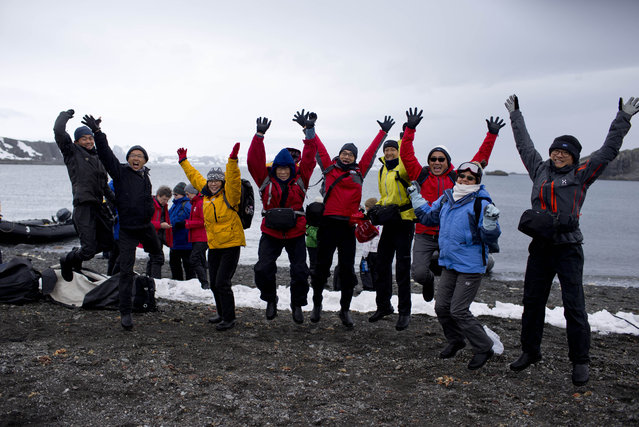
In this February 2, 2015 photo, tourists jump as they pose for a picture, after disembarking from the Ocean Nova cruise ship, on King George Island, Antarctica. This tourist season, which runs November through March, more than 37,000 visitors are expected to walk on the coldest continent on Earth, about 10 percent more than the year before. (Photo by Natacha Pisarenko/AP Photo)
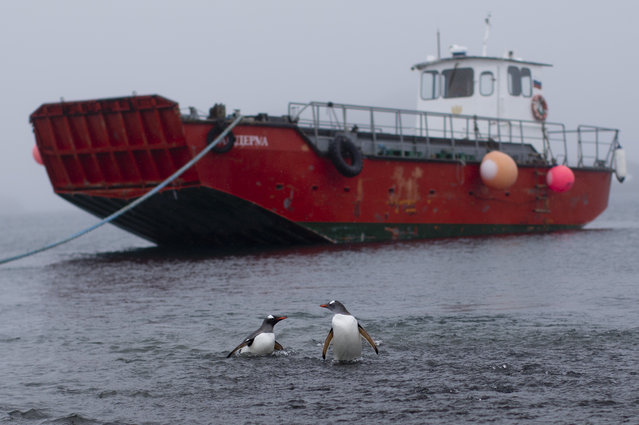
In this January 21, 2015 photo, two penguins wade in the water near the Chilean station Escudero in King George Island, Antarctica. While some tourists climb Mount Vinson, Antarctica's highest point at 16,050 feet (4,892 meters), others seek a chance to take in the views of other-worldly terrain or enjoy watching hundreds of penguins bop in and out of the water. (Photo by Natacha Pisarenko/AP Photo)
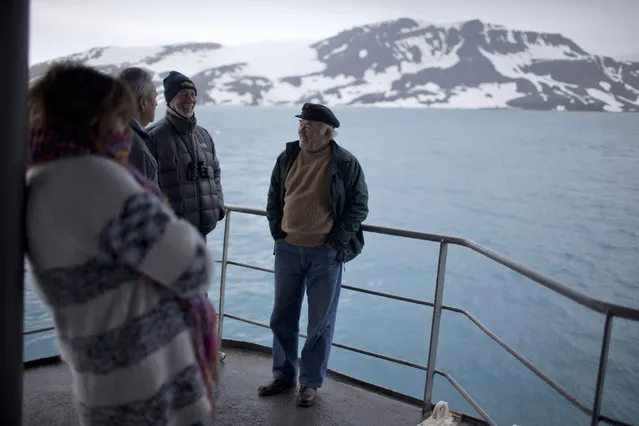
In this January 27, 2015 photo, tourists stand on The Aquiles, a Chilean Navy icebreaker, near Bahia Almirantazgo, Livingston Island, South Shetland Island archipelago, Antarctica. Although many tourists are nature-loving retirees who mostly stay aboard cruise ships, conservationists worry about potentially devastating environmental damage from boat pollution and from the more adventurous visitors who hike or cross-country ski around sensitive sites. (Photo by Natacha Pisarenko/AP Photo)

In this January 22, 2015 photo, Chilean tourists Estela Dorion, left, and Renato Valenzuela, wait on the deck of The Aquiles, a Chilean Navy icebreaker, for a zodiac that will transport them to the Bernardo O'Higgins scientific station, Antarctica. The harsh environment requires vacationers to come with many essentials: water-resistant hiking boots, several layers of winter clothes including long underwear and a parka, and powerful sun lotion and dark shades with extra ultraviolet protection. (Photo by Natacha Pisarenko/AP Photo)
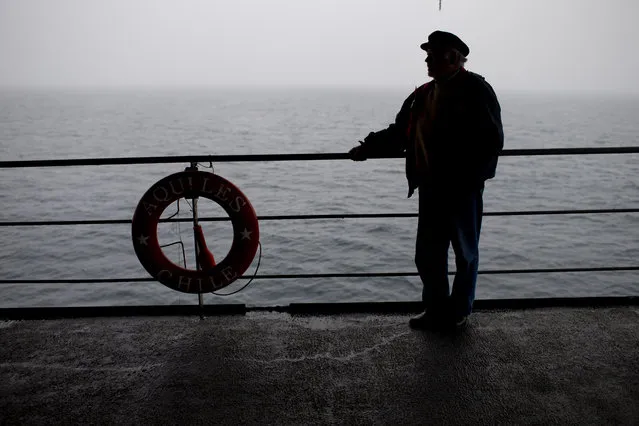
In this January 25, 2015 photo, tourist Juan Enrique Kemp stands aboard The Aquiles, a Chilean Navy icebreaker, near Byers Peninsula, Livingston Island, in the South Shetland Islands archipelago, Antarctica. “In Antarctica, you can plan all you like, but you can't really schedule anything”, goes a local saying. (Photo by Natacha Pisarenko/AP Photo)
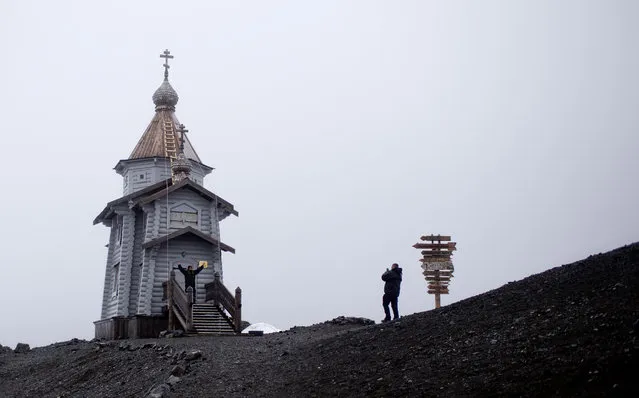
In this January 28, 2015 photo, tourists take pictures at the entrance of the world's southernmost Eastern Orthodox church, the Holy Trinity, located on top of a rocky hill on King George Island, Antarctica. Russian priests here rotate in for yearlong stints, primarily to celebrate Mass for the workers on the Russian Bellinghausen base. (Photo by Natacha Pisarenko/AP Photo)
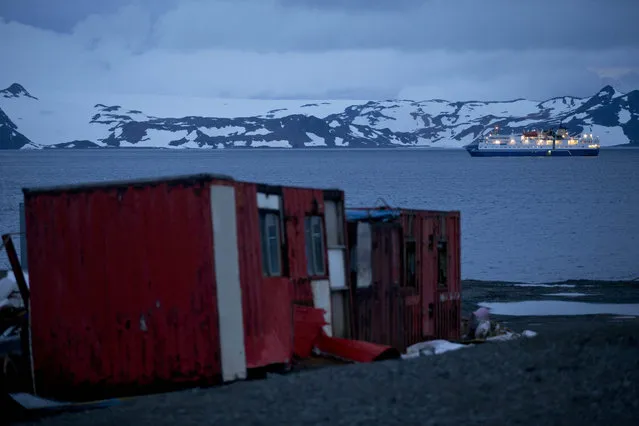
This February 2, 2015 photo shows the Ocean Nova cruise in Maxwell Bay, near King George Island, Antarctica. Antarctica is roughly the size of United States and Mexico combined, but tourists and the 4,000 or so scientists who live here part of the year mostly keep to areas that aren't permanently frozen and where wildlife can be found. Those areas account for less than 2 percent of the continent. (Photo by Natacha Pisarenko/AP Photo)
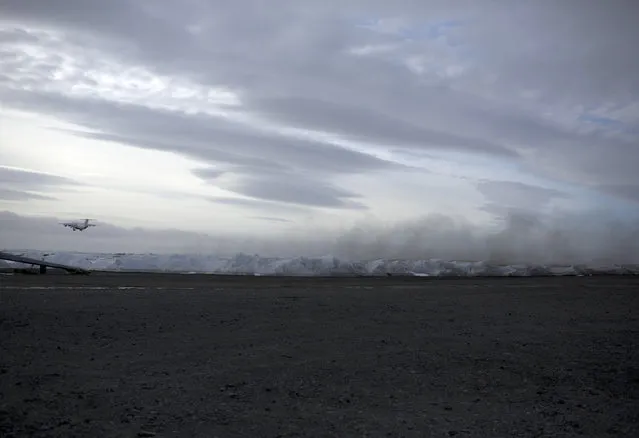
In this January 20, 2015 photo, a plane departs from King George Island, Antarctica. No matter how tourists arrive, weather delays are the norm. During a recent patch of heavy fog, for six days planes were unable to take off or land on King George, leaving guides to deal with frustrated tourists. (Photo by Natacha Pisarenko/AP Photo)
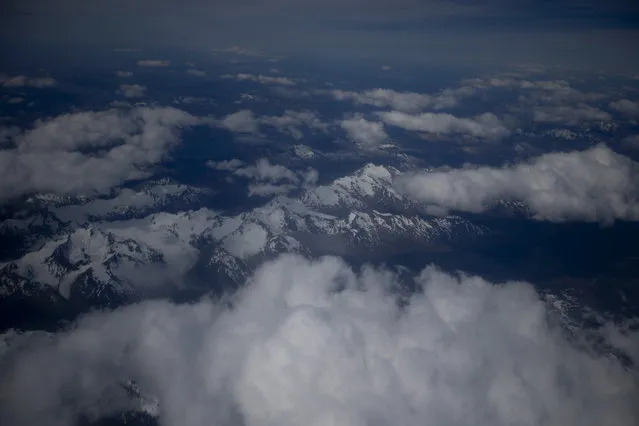
This January 20, 2015 aerial photo, shows the terrain that is seen on a flight from Punta Arenas to King George Island, Antarctica. No matter how tourists arrive, weather delays are the norm. During the recent patch of heavy fog, for six days planes were unable to take off or land on King George, leaving guides to deal with frustrated tourists. (Photo by Natacha Pisarenko/AP Photo)
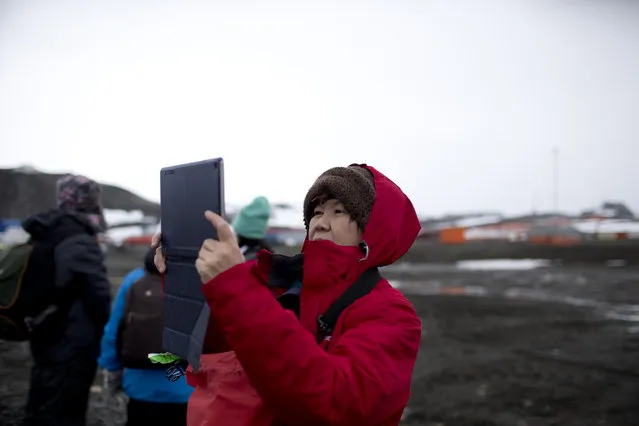
In this February 2, 2015 photo, a tourist uses a tablet to make a picture after disembarking from the Ocean Nova cruise ship, on King George Island, Antarctica. Most visitors arrive on the Antarctic Peninsula, accessible from southern Argentina and Chile by plane or ship. The next most popular destination is the Ross Sea on the opposite side of the continent, which visitors reach after sailing 10 days from New Zealand or Australia. (Photo by Natacha Pisarenko/AP Photo)

In this January 27, 2015 photo, boats sit on the beach at Bahia Almirantazgo, Antarctica. Most visitors arrive on the Antarctic Peninsula, accessible from southern Argentina and Chile by plane or ship. The next most popular destination is the Ross Sea on the opposite side of the continent, which visitors reach after sailing 10 days from New Zealand or Australia. (Photo by Natacha Pisarenko/AP Photo)
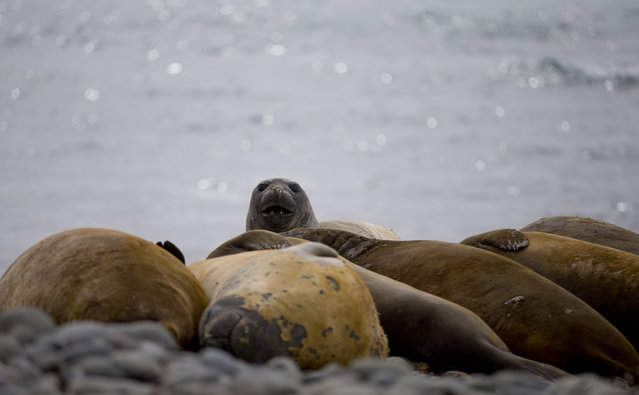
In this January 24 2015 photo, elephant seals rest on the beach in Robert Island, in the South Shetland Islands archipelago, Antarctica. It's the last terrestrial tourism frontier that nature lovers, adventurers and explorers are rushing to visit. This tourist season, which runs November through March, more than 37,000 people are expected to visit the coldest continent on Earth, about 10 percent more than last season. (Photo by Natacha Pisarenko/AP Photo)
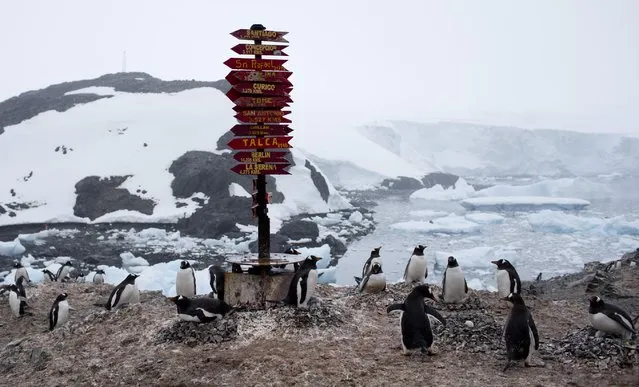
In this January 22, 2015 photo, Gentoo penguins gather near a post of wooden arrows with names of cities and their respective distances, at the Bernardo O'Higgins scientific station, Antarctica. Increasing foot traffic poses “particular risks of disturbance or contamination to some of the last remaining essentially pristine areas on the planet”, said Alan Hemmings, an environmental consultant on polar regions. “We should not passively watch Antarctica being turned into a theme park”. (Photo by Natacha Pisarenko/AP Photo)
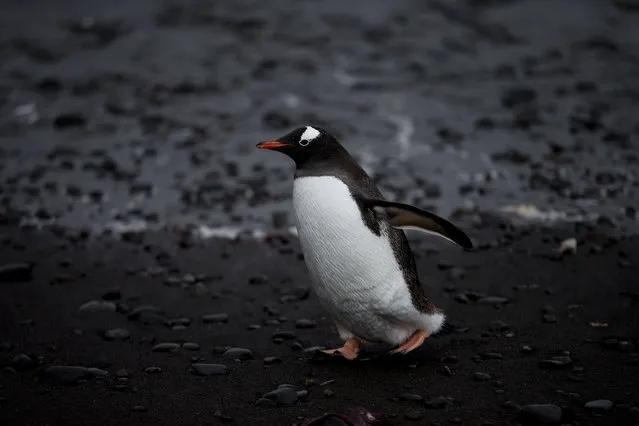
In this January 26, 2015 photo, a Gentoo penguin waddles past on the shore of Punta Hanna, Livingston Island, South Shetland Island archipelago, Antarctica. While some tourists climb Mount Vinson, Antarctica's highest point at 16,050 feet (4,892 meters), others seek a chance to take in the views of other-worldly terrain or enjoy watching the penguins. (Photo by Natacha Pisarenko/AP Photo)
22 Mar 2015 11:31:00,
post received
0 comments
